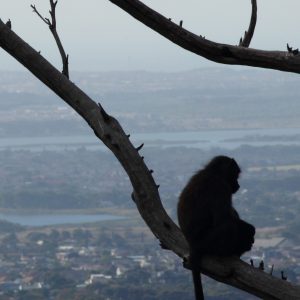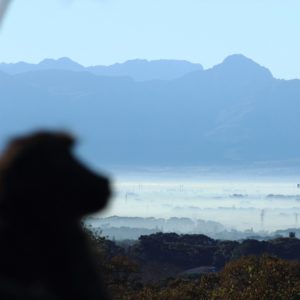Baboons in Town !
In collaboration with scientists from Swansea University’s College of Science and the Institute for Communities and Wildlife in Africa, we are trying to better understand the human-baboon conflict. The work presented here has been conducted as part of my PhD.
Our Work

Adaptive space use
Growing human populations are increasingly competing with wildlife for limited resources and this can result in chronic human–wildlife conflict. In South Africa, chacma baboons (Papio ursinus) are foraging on a variety of human‐derived foods in urban and rural areas. To solve this human-baboon conflict, field rangers are hired to bring the baboons back to their natural environment. This strategy is largely successful, reducing the time baboons spend in the urban spaces to less than 2%. However, some baboons found a loophole in the strategy and find ways of venturing into urban areas to exploit high energy food resources.
Spying on raiding baboons
Whilst the field rangers are successful at minimizing human-baboons’ conflicts, some males were still finding ways in. We therefore wanted to understand how the baboons were doing this. However, urban ventures are so fast, so intense, that we couldn’t keep up following them by foot in urban areas with high walls and security fences. We had to find another method to document the very special techniques baboons were adopting when raiding. We applied new motion sensor technologies to quantify how much an animal moves in the three dimensions. Such methods have been used for more than a decade, but mainly on birds or sea mammals.


Equilibrate costs and rewards
Sometimes, people fear that baboons do not have any better choice than going in the urban environment to forage due to human encroachment over natural areas. We mapped baboon food sources and the probability of encountering field rangers over the area and we found that while baboons were able to find food sources in the natural environments with low risks, they can find 10 times richer food items in the urban environments!
Meet the team!
A special thank you to everyone involved, this work would not have been possible without you!
Head of Swansea University’s SHOALgroup in the College of Science, senior scientist on the project
Director of iCWild, principal field advisor
Associate Professor, part of the SLAM group, Tech – advisor
Chair in geography, GIS – advisor
Technical advisor
Computer science advisor
Field advisor
Field assistant, researching wildlife and humans
Field assistant
Master student
Master student
Undergraduate intern
Undergraduate intern
